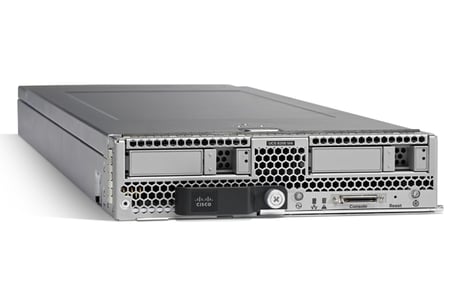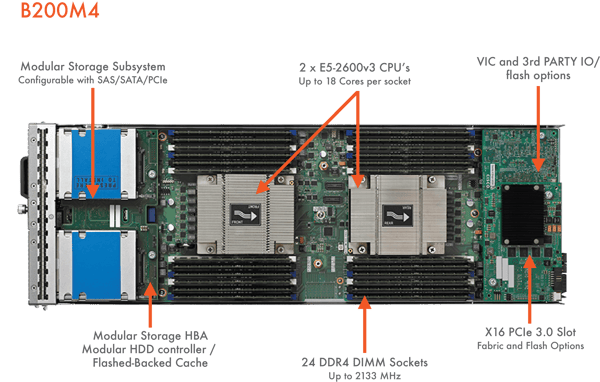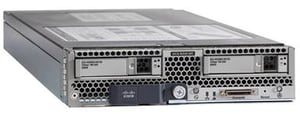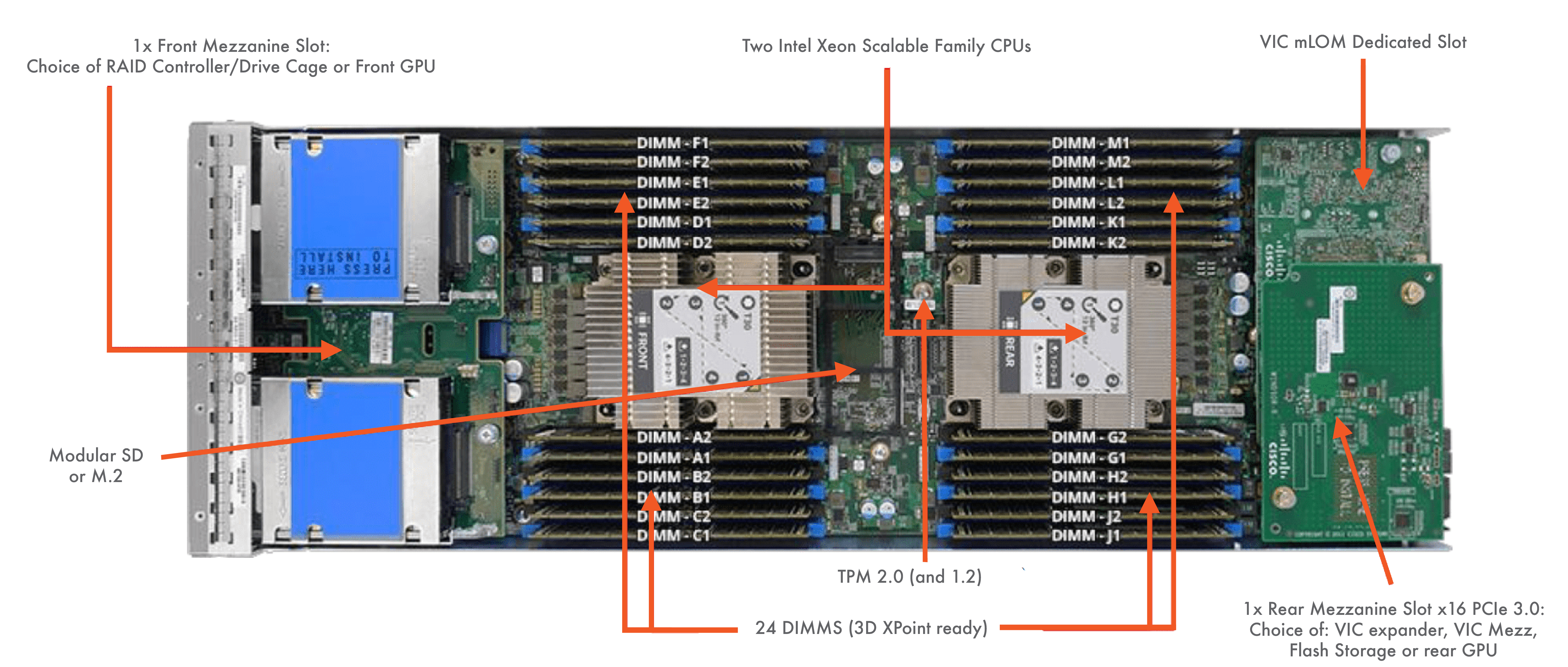Comparison: Cisco UCS B200 M4 vs. Cisco UCS B200 M5

Today we'll look at two excellent blade servers from the Cisco UCS B-Series, namely, the B200 M4 and the B200 M5. Cisco's UCS B-Series Blade Servers run on Intel® Xeon® processors and work with virtualized and non-virtualized applications. These applications allow for an increase in performance, energy efficiency, flexibility, and administrator productivity.
When working with servers, common pain points are cost management, remote control, doing more with less, security, and transitions. Both the M4 and M5 have their own unique strategies in combating these pain points to relieve your day-to-day operation.
A Few Things To Remember
The key is to let the servers work for you. The best way to do so is to understand what each server is specifically used for and to know how/if they can fulfill your needs. Whichever way you figure your cost/benefit figure, whether it be dollar/unit of storage, dollar/server/rack, or dollar/rack, knowing that breakdown gets you the best "bang-for-your-buck" or "B200-for-your-buck".
Download the guide and refer back to it at any time!
In a growing technology market, bandwidth and space play a major role. Accomplishing more for your business with minimal space addresses an essential factor in improving your bottom line. This leads to a concern, security. Introducing systems with security that suit your needs is as important as the device itself. Let's dive into how the servers unpack these solutions in their own unique way.
Cisco UCS B200 M4 Blade Server
The Cisco Unified Computing System uses Cisco UCS B-Series Blade Servers, along with networking and storage access, simplified management, cost efficiency, increased visibility, and control in the data center networks.
The UCS B200 M4 Blade Server delivers performance, flexibility, and optimization for data centers around the world and it can be deployed remotely. This Cisco B200 server offers market-leading performance, versatility, and density. It is capable of a wide range of workloads ranging from web infrastructure to distributed databases within networks. The Cisco UCS B200 M4 server can quickly deploy stateless physical and virtual workloads with the programmable ease and simplicity of the Cisco UCS Manager Software.

Cisco UCS B200 M4 Features
- 24 DIMM slots for industry-standard DDR4 memory with speeds up to 2400 MHz while offering up to 1.5 TB of total memory when using 64 GB DIMMs.
- The B200 M4 has two optional, hot-plug SAS and SATA hard disk drives (HDD’s) or solid-state drives (SSD’s).
- Cisco UCS Virtual Interface Card (VIC) 1340, is a 2-port - 40 GB Ethernet Fiber Channel (FCoE).
- Delivers 80 Gbps to the server.
- Adapts to either 10 or 40 Gbps fabric connections.
- Cisco Flex Storage local drive subsystem provides flexible boot and local storage capabilities, allowing optional support for an NVIDIA M6 GPU.
- Configure the Cisco UCS b200 M4 to meet your local storage requirements without having to buy unnecessary power and cooling components.
- Choose an enterprise-class RAID controller, or go without any controller and drive bays if you're not utilizing local drives.
- Easily add, change, or remove Cisco FlexStorage modules.
- The Cisco UCS B200 M4 server is a half-width blade. Up to eight can reside in the 6-rack unit.

Cisco UCS Options
PivIT doesn't stop with offering the B200 M4 or M5 servers. Click here to view the other UCS comparisons and highlighted products we've covered to help navigate your next server choice.
Cisco UCS B200 M5 Blade Server
The enterprise-class Cisco UCS B200 M5 Blade Server delivers market-leading performance, versatility, and density without compromise. Ranging from web infrastructure to distributed databases and networks. Depending on your setup, it can be difficult to manage and have stable control over your remote sites. The Cisco UCS B200 M5 is used for remote sites and data centers to mitigate this pain point we often see.
The Cisco UCS B200 M5 server is a half-width blade. Up to eight servers can reside in the 6-rack-unit, offering one of the highest densities per rack of blade chassis in the industry. You can depend on the Cisco UCS B200 M5 to meet your local storage requirements without having to buy power and cooling components that are unnecessary. The Cisco UCS B200 M5 is designed for achieving high-class performances in your data centers. By combining intelligence with automated actions, you can reduce costs dramatically and accelerate time to resolution.

Cisco UCS B200 M5 Features
- The Cisco UCS B200 M5 can provide up to two Intel Xeon Scalable CPU’s with up to 28 cores per CPU.
- 24 DIMM slots for industry-standard DDR4 memory at speeds up to 2666 MHz with up to 3 TB of total memory when using the 128-GB DIMMs.
- Modular LAN on motherboard (mLOM) card, Cisco UCS Virtual Interface Card (VIC) 1340, 2-port and 40-GB Ethernet, Fibre Channel over Ethernet (FCoE)-capable mLOM mezzanine adapter.
- Optional rear mezzanine VIC with two 40 GB ports or two sets of 4 x 10 GB unified I/O ports, delivering 80 Gbps to the server. Adapting to either 10 or 40 Gbps fabric connections.
- Two optional, hot-pluggable, HDD’s, SSD’s, or nonvolatile Memory Express 2.5-inch drives with a choice of an enterprise-class RAID or pass through controllers.
- Support for SD cards or M.2 SATA drives for flexible boot and local storage capabilities.
- Support for 2 optional GPU’s.
- Support for one rear storage mezzanine card.
- Support for one 16-GB internal flash USB drive.

A Quick Side Note A powerful counterpart to any UCS server is the Cisco UCS Performance Manager. The UCS Management software provides visibility from a single console into UCS components for performance monitoring and capacity planning. It provides data center assurance of integrated infrastructures and ties application performance to both, physical and virtual infrastructure performance. This allows network engineers to optimize resources and deliver the best services for their clients. It also unifies the monitoring of key applications, business services, and integrated infrastructures, thereby, Stretching across dynamic, heterogeneous, physical, and virtual Cisco UCS-powered data centers. The Cisco UCS Manager allows servers to be provisioned in minutes instead of days, shifting your focus away from maintenance to strategic initiatives.
Putting the Two Servers Head To Head
| Features | CISCO UCS B200 M4 | CISCO UCS B200 M5 |
| # Processors | 2 | 2 |
| Supported Processors | Intel® Xeon® E5-2600 v4 and V3 processor product families | Intel® Xeon® Scalable Processors |
| Memory | 1.5 TB, 24 x DDR4 DIMM's | 3.0 TB, 24 DDR4 DIMM's |
| Form-Factor | Half-width blade | Half-width blade |
| Built in RAID | 0, 1 | 0, 1 |
| Mezzanine I/O | 2 Slot | Up to 3 Slots |
| GPUs | 1 | Up to 2 |
| Max Throughput | (2 x 40 Gbps) | (2 x 40 Gbps) |
| STORAGE | ||
| Internal Storage | Internal Storage | |
| Up to two SAS/SATA/SSD/NVM | Up to two SAS/SATA/SSD/NVM | |
| Maximum internal storage, 6.4 TB | Maximum internal storage, 20.5 TB | |
The goal is to understand which server best fits your needs, not to beat the other out of a spot on your rack. Our team will not only help identify your needs, but they will help get you set up with the proper gear to mitigate those pain points. Whether that's buying new (M5) or supporting N-1 generation gear (M4), we will help you meet your needs and accomplish your goals.
Need To Support One of These Devices?
Learn how OneCall makes your maintenance even easier! OneCall is a proud member of the Service Industry Association. OneCall keeps its promises and we're here to help support your networks however you need us to!
Check Out Similar Comparisons & Resources
- Cisco UCS M5 Server Comparison: B200 M5 and B480 M5
- Newly Released, 3rd Gen. Intel-Powered UCS B200 M6 is Worth the Excitement
- An Enterprise-Grade Server For Your Environment: The Cisco UCS B480 M5
- Dell EMC PowerEdge MX840c vs. Cisco UCS B480
*Updated 7/21/2021